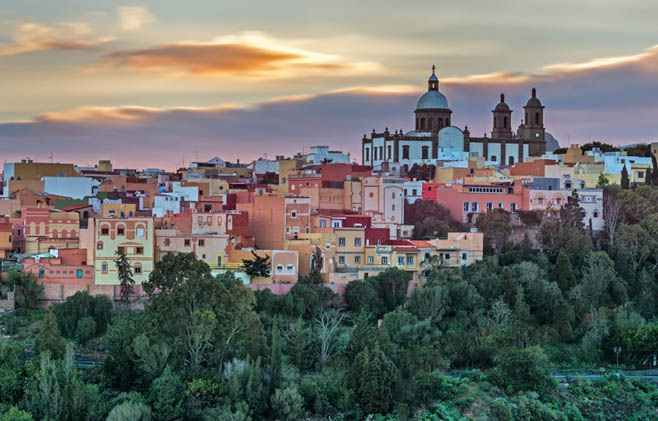 The greatest attraction of the eastern, a bit sunburned part of Gran Canaria is the evergreen Baranco de Guayadeque, in which to this day people live in houses arranged in rock caves.
The greatest attraction of the eastern, a bit sunburned part of Gran Canaria is the evergreen Baranco de Guayadeque, in which to this day people live in houses arranged in rock caves.
Aguimes
Fr. 30 km from the capital of the island Aguimes is one of the first and most beautiful Spanish settlements, which arose on the island, which due to the beautiful old town hidden in not very interesting suburbs is often called "hidden diamond". The Old Town is narrow streets with traditional white houses, squares and lawns, among which intriguing sculptures suddenly emerge – e.g.. lying on the street… camel. The Iglesia de San Sebastian dominates the town – temple built between 1796-1940, which is considered to be one of the most beautiful on the island. To learn a bit more about the town, it is worth visiting the Centro Interpretación del Casco Histórico on the Plaza de San Antón, also acting as a tourist information office. A visit to the Museo Histórico in the bishop's palace is also going to be interesting, where exhibitions about Guanches have been prepared, conquest, later emigration and regional folklore.
Buses from Las Palmas travel to Aguimes several times a day and a bus from Maspalomas several times a day.. One of the most appreciated traditional restaurants, Seńorio de Aguimes, is also operating here.
Guayadeque ravine
The town of Aguimes crouched at the mouth of the mighty one, evergreen gorge, which seems to divide the island in half. Hundreds of meters high slopes, jagged rocks, lush green, and in the spring flowering almond groves make, that the canyon is one of the most beautiful places in Gran Canaria. In the old days, the Guanches lived in caves carved into steep slopes, from which language the name of the gorge comes -guayadeque means "place, in which the water flows ". The caves of the first inhabitants of Gran Canaria are still visible today, and what's interesting, in houses carved in rock, there are still people living. Most of the modern troglodytes are concentrated in the town of Cuevas Bermejas, where even a small church was carved in the bag.
Barranco de Guayadeque is easily accessible, because there is a convenient road in its middle. Before entering the gorge, there is the Centro de Interpretación, in which an exhibition introducing the Guanche culture was organized. To see, what modern caves look like from the inside, you just need to enter one of the two restaurants – El Centro in Cuevas Bermejas or Tagoror in the depths of the gorge.
Ingenuity
The town on the other side of the mouth of the Guayadeque Gorge is worth seeing. You can start your visit in the main square – Plaza de la Candelaria, next to which stands the church of the same name with 1901 r. The church bells were given to the city by emigrants, who left Gran Canaria for Cuba. A bit north, Parque Nestor Alamo is surrounded by colorful houses on the Plaza de Candelaria, in which a restored windmill grows.
The historic Casa Postas has a tour desk – you can get a good map of hiking trails there.
Counted
The second largest city of Gran Canaria is rather overlooked by tourists, who don't know, that inside the industrial suburb and modern buildings there is a nice old town. Its central point is Plaza de San Juan with the 15th-century church of St.. John the Baptist. It's worth taking a look inside – an interesting statue of Christ dominates inside, made by Mexican Indians out of corn mass. Beautifully restored merchant tenement houses stand in the streets around the square. At the end of the cobbled wall of Ines Chanida, there is a completely different atmosphere – among modest traditional buildings stands the small Iglesia de San Francisco. In the town, you can also visit the Museo León y Castillo in the house of the famous Canarian politician who hails from the city. Pictures were collected inside, furniture, historical documents and weapons.
Information about the town can be obtained from the tourist information office near the main square of the old town.
Four doors
Gran Canaria has the most souvenirs of the original inhabitants of the Canary Islands. One of the most important archaeological sites is the Cuatro Puertas hill, where numerous groups of caves carved in the rock by the Guanches were discovered. According to historians, they served as a shelter and workshop for people, which included the task of embalming the dead or as a temporary residence for girls waiting for marriage. Four doors, meaning "four doors” – is a spacious cave carved in the northern slope, to which there are four entrances; of Almoga – a place of worship of the ancient Canarians, which served as a sacrificial altar; Cave of the Pillars – a group of arrowheads on the southern slope of the mountain, connected by internal corridors and stairs; there is also another cave, Cave of Papers.